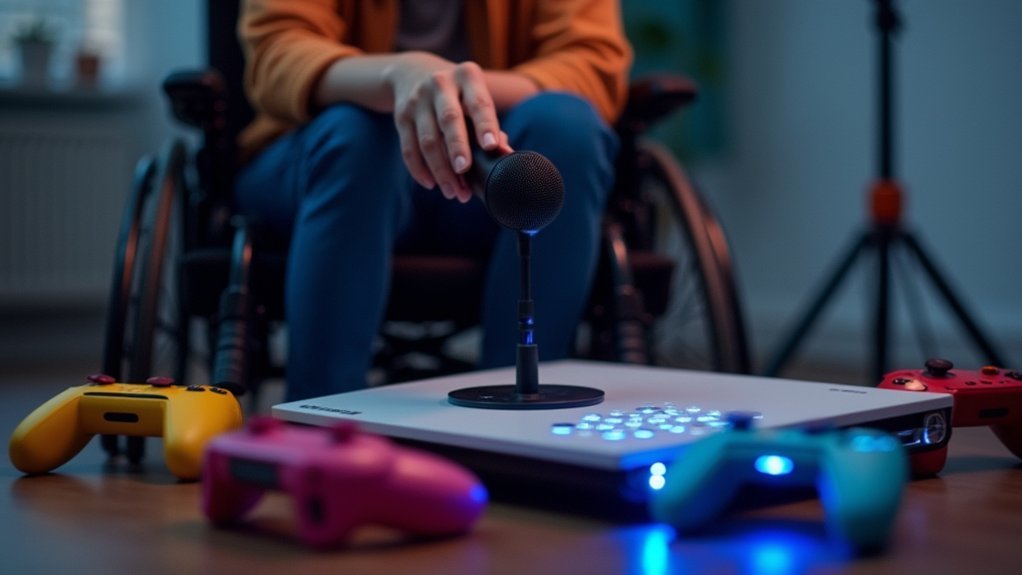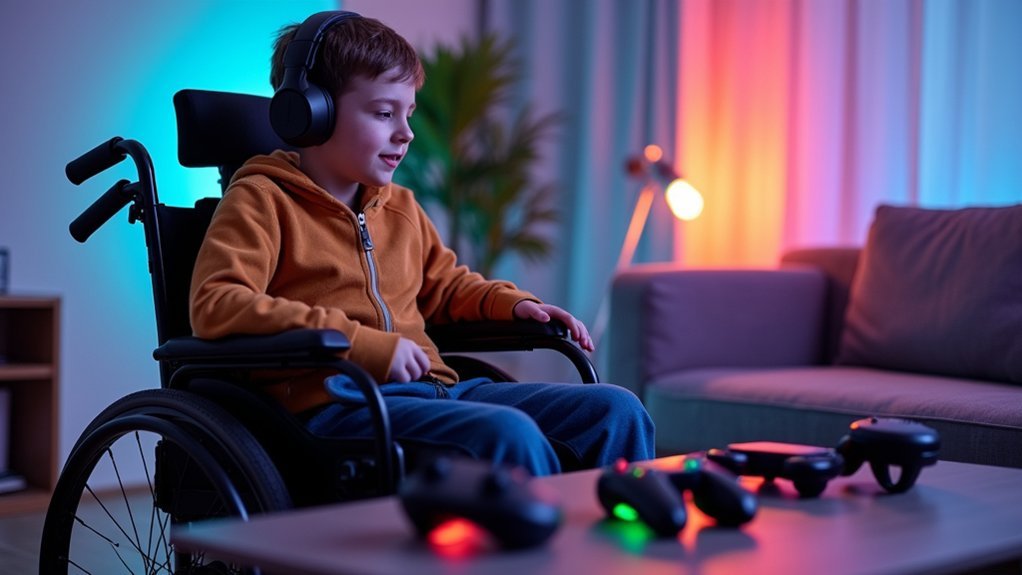Voice-activated games offer a transformative solution for limited mobility players, allowing you to control gameplay through speech commands. Technologies like VoiceAttack and VoiceBot let you customize commands while major platforms from Sony, Nintendo, and cloud gaming services increasingly integrate voice features. With proper setup—quality headset, M-Game software, and fast internet—you’ll experience responsive gameplay despite physical limitations. Latency has improved to as low as 25ms in cutting-edge systems, opening worlds of gaming possibilities you never thought accessible.
The Power of Voice: Opening Gaming Worlds for Limited Mobility Players

While traditional gaming has long relied on physical controllers, voice-activated technology is revolutionizing accessibility for players with limited mobility. You’re now able to issue commands, control characters, and interact with virtual worlds simply by speaking.
This advancement means you don’t need to struggle with complex button combinations or physical movements that might be challenging. Modern voice recognition software filters out background noise and improves command accuracy, though some systems still face responsiveness issues. The affordability of these assistive technologies remains a significant concern, with 30% of gamers citing cost as their biggest accessibility barrier.
Voice controls eliminate complex buttons and movements while advanced recognition systems improve accuracy despite ongoing responsiveness challenges.
You’ll find many games now include customizable voice commands, letting you tailor the experience to your specific needs.
While high-end voice tools can be expensive and compatibility issues exist across platforms, these technologies continue to evolve, creating more inclusive gaming environments where physical limitations no longer determine your ability to play.
Understanding Different Mobility Challenges in Gaming
When you consider the gaming landscape, mobility challenges represent a significant barrier for approximately 20-30% of all players. These challenges manifest in various forms beyond what you might initially imagine.
Physical disabilities like paralysis or limited dexterity directly affect controller usage, while neurological conditions such as Parkinson’s or cerebral palsy impact coordination and precision.
You’ll find that cognitive impairments require simplified interfaces, and sensory disabilities necessitate alternative input methods entirely.
Many players also contend with chronic conditions like fibromyalgia, where pain and fatigue limit gaming sessions. AbleGamers’ Player Panels provide critical insights from individuals with these varied mobility challenges, helping developers understand their specific needs.
These diverse challenges explain why 66% of disabled gamers report barriers to participation, despite their desire to engage. Understanding these distinct mobility challenges is vital for developing truly accessible voice-activated gaming solutions.
Current Voice-Activated Game Options on the Market

As voice recognition technology matures, you’ll find an increasingly diverse range of voice-activated games catering to players with limited mobility. Companies like Volley Games, which recently secured $55M in funding, are leading the market with accessible gaming experiences.
Voice-activated gaming unlocks new worlds for mobility-challenged players through rapidly advancing recognition technology.
Major players including Sony and Nintendo are integrating voice command features, while tech giants Apple and Google leverage their voice assistants to enhance gameplay accessibility.
You’ll notice AI-driven games now respond to more complex voice commands, creating deeper interactive experiences.
Cloud gaming platforms have particularly embraced voice activation, offering smoother experiences without hardware limitations.
For AR/VR enthusiasts, voice commands are becoming essential control mechanisms, opening immersive worlds to those with mobility challenges. These technologies offer real-time feedback, making gameplay more intuitive and responsive than ever before. Voice Recognition systems can now capture player commands by identifying up to 78 facial points simultaneously, creating an additional layer of accessibility for users with various mobility needs.
How Voice Recognition Technology Works in Gaming Systems
Voice recognition in gaming systems relies on speech-to-text conversion, natural language processing, and machine learning algorithms that interpret your commands into game actions.
Your voice inputs pass through noise cancellation filters before being processed by specialized software like VoiceAttack, which translates spoken words into digital commands the game can understand.
These systems continually improve response times by learning from your speech patterns and reducing the processing steps between your verbal command and the on-screen action. Additionally, software like VoiceAttack enables players to create powerful macros for keyboard and mouse actions, making games more accessible for those with limited mobility.
Voice Recognition Core Components
To understand how voice-activated games function for players with limited mobility, you’ll need to grasp the fundamental components that power voice recognition technology. These systems rely on sophisticated speech recognition algorithms that convert your spoken words into text that gaming platforms can process.
At its core, the technology captures audio through microphones, analyzes your speech patterns, and converts them into actionable commands. The system interprets these commands by matching them with predefined in-game actions, then executes them in real-time. This approach creates a hands-free gameplay experience that significantly benefits users with limited mobility.
This technology requires high-quality hardware and compatible software that works across various gaming platforms. As you speak, the system processes your unique voice characteristics, including accent and speech patterns, enabling responsive gameplay without traditional physical inputs—a game-changing advancement for players with mobility challenges.
Processing Natural Speech
When you speak to a modern gaming system, complex natural language processing algorithms immediately begin interpreting your words beyond simple command recognition.
These systems analyze your tone, emotions, and context using neural networks that have reduced error rates from 25% to under 5% in recent years.
Your natural speech patterns—including background noise and varied pronunciations—are processed through speech-to-text conversion, eliminating the need to memorize specific commands.
This technology adapts to how you naturally speak rather than forcing you to adapt to it.
For players with limited mobility, this means true hands-free gaming that integrates seamlessly with other assistive technologies.
You’ll notice games respond to normal conversational language, understand multiple languages, and even react appropriately to your emotional state during gameplay.
The implementation of these advanced voice features has created more inclusive gaming experiences, increasing accessibility for 15% more players with mobility limitations.
Improving Latency Factors
While you’re immersed in gameplay, latency—the delay between speaking a command and seeing the resulting action—can make or break your experience.
Today’s voice recognition systems target sub-50ms latency, with cutting-edge solutions achieving just 25ms.
You’ll benefit from games utilizing on-device processing and edge computing, which minimize data travel distance. Recent technological advancements have made human-like interactions possible by reducing response time well below the 150ms threshold of human perception.
AI-powered features like incremental speech processing and noise suppression enhance clarity without sacrificing speed.
For players with limited mobility, these improvements aren’t just convenient—they’re game-changing.
Low-latency voice commands provide competitive advantages through faster coordination and real-time callouts. They also create more immersive storytelling experiences as AI-driven characters respond naturally to your voice.
Network optimizations, including strategically placed servers and traffic prioritization, further reduce delays, making voice-activated gaming more accessible and responsive.
Beyond Gaming: Cognitive Benefits of Voice-Activated Play
Voice-activated gaming offers you tangible brain training benefits as you engage with interfaces that challenge multiple cognitive pathways simultaneously.
Your brain’s neuroplasticity—its ability to form new neural connections—gets exercised when you use voice commands that require precise timing, clear articulation, and rapid decision-making.
You’ll likely experience improved verbal fluency, enhanced attention spans, and better executive functioning through consistent practice with voice-controlled play. Research shows that voice interaction in games creates a deeper social connection with technology, potentially amplifying cognitive engagement beyond traditional gaming interfaces.
Brain Training Benefits
Three major cognitive advantages emerge when players engage with voice-activated games beyond mere entertainment.
First, you’ll experience enhanced decision-making and verbal clarity through repeated voice interactions that stimulate brain regions associated with attention and memory. The constant practice improves your speech articulation and command timing. Recent research confirms that video games positively impact cognitive function, particularly with enhanced attention abilities observed across multiple studies.
Second, these games create a state of flow that increases your cognitive engagement, especially beneficial if you’re an older adult seeking memory improvement or a child developing attention skills. The interactive nature promotes quick thinking and reflex development.
Third, there’s a therapeutic dimension – voice-activated environments serve as effective tools for cognitive training in rehabilitation settings. For those with speech disorders, these games offer personalized learning experiences that adapt to your specific needs while improving cognitive flexibility.
Neuroplasticity in Action
As your brain engages with voice-activated games, it undergoes remarkable neuroplastic changes that extend far beyond entertainment value. You’re actually rewiring neural pathways, particularly in areas controlling attention, memory, and executive function. Your prefrontal cortex and hippocampus show increased activity during these interactions, creating lasting cognitive benefits. Research shows that puzzle game mechanics can significantly impact problem-solving abilities while enhancing fluid intelligence.
| Brain Region | Function | Gaming Benefit |
|---|---|---|
| Prefrontal Cortex | Executive Function | Enhanced decision-making |
| Hippocampus | Memory Formation | Improved retention |
| Broca’s Area | Speech Production | Better articulation |
| Temporal Lobe | Auditory Processing | Fine-tuned listening |
These neuroplastic adaptations are especially valuable if you have mobility limitations. Each voice command you issue strengthens neural connections, improving your verbal clarity and cognitive flexibility through consistent practice—making these games powerful rehabilitation tools beyond their entertainment value.
Setting Up Your Voice-Controlled Gaming Environment

When setting up a voice-controlled gaming environment, you’ll need to take into account both hardware and software requirements to guarantee smooth gameplay without traditional controllers.
Start with M-Game software and a quality headset to ensure clear audio input. A fast internet connection is vital for processing voice commands efficiently.
For software, consider VoiceBot or VoiceAttack, which allow you to create custom voice commands. You’ll need to set up macros that translate your voice inputs into game actions. Proper microphone configuration, including audio level adjustments, is essential for accurate recognition.
Don’t forget to enable Wake-on-LAN features and explore integrating your gaming setup with smart home devices for a more immersive experience. For ethernet-connected PCs, you can configure Wake on Magic Packet in Device Manager to enable voice-controlled PC startup.
Group your devices for easier control with single commands.
Success Stories: How Voice Gaming Changes Lives
The transformative power of voice-activated gaming technology has revolutionized accessibility for players with limited mobility. These innovations create pathways to independence, social connection, and renewed gaming enjoyment. Continuous assessment and updates are essential for enhancing access, ensuring voice-activated gaming solutions remain effective for users with diverse needs.
| Player Impact | Technology Solution | Outcome |
|---|---|---|
| Physical Barriers | AI Assistants like Fridai | Independent gameplay without physical controls |
| Social Isolation | Text-to-speech in Ghost Recon | Meaningful multiplayer participation |
| Dependency | Custom solutions like QuadControl | Self-sufficiency in gaming sessions |
| Limited Options | Microsoft’s Adaptive Controller | Expanded game library accessibility |
You’ll find the gaming community increasingly supportive of these accessibility features, with developers responding through continued innovation. Players report heightened engagement and enjoyment when using voice controls, finally experiencing games on their own terms without assistance from others.
Overcoming Speech Recognition Barriers and Limitations

Despite significant advancements in voice recognition technology, players with limited mobility still face several challenges when using these systems. Background noise, accents, and dialects can lead to frustrating misinterpretations that disrupt gameplay experiences.
Voice recognition still struggles with background noise and diverse speech patterns, creating barriers for mobility-impaired gamers.
You’ll find that developers are addressing these issues through robust error correction mechanisms and contextual understanding models trained on real-world data. Regular updates to voice recognition systems continuously improve accuracy over time.
Privacy concerns are being mitigated through anonymization techniques and transparent data policies that give you control, including opt-out options. Meanwhile, the implementation complexity and costs are being managed through cloud-based services from major providers, though small game developers still face significant transcription costs of approximately $35 per week.
Well-designed interfaces with immediate feedback help build your trust in these systems, while educational resources explain both benefits and limitations, increasing overall acceptance.
The Future of Voice Commands in Inclusive Game Design
Looking ahead at voice commands in gaming, you’ll witness a revolutionary convergence of AI, specialized hardware, and advanced speech recognition that’s reshaping inclusive game design.
As legislative frameworks support accessibility and major studios embrace inclusive features, you’re entering an era where voice activation isn’t just an adaptation, but a foundational design element.
- You’ll experience AI-personalized voice commands that adapt to your unique speech patterns.
- You’ll benefit from cross-platform compatibility, allowing seamless gaming across devices.
- You’ll see previously complex genres become accessible through innovative voice control solutions.
- You’ll contribute to game development through direct feedback channels for players with disabilities.
- You’ll discover new gameplay mechanics specifically designed around voice interaction.
This evolution isn’t just expanding the market—it’s transforming how everyone experiences games. New haptic controllers providing tactile feedback will complement voice commands, creating multi-sensory gaming experiences for players with various sensory impairments.
Frequently Asked Questions
Can Voice-Activated Games Work Offline or With Intermittent Internet Connections?
Yes, you’ll find many voice-activated games work offline using local voice recognition engines. Some offer hybrid functionality, maintaining basic commands offline while accessing advanced features when you’ve got internet connectivity.
How Do Voice Commands Accommodate Players With Speech Impediments?
Voice commands can accommodate your speech impediment through AI systems that learn your unique patterns, personalized settings that adjust sensitivity, and alternative command options when you struggle with specific sounds or pronunciations.
Are There Privacy Concerns With Always-Listening Voice Recognition Systems?
Yes, you should be concerned about always-listening systems. They capture voice biometrics that can identify you, may inadvertently record sensitive information, and often store your data in the cloud where breaches can occur.
What Accessibility Certifications Should I Look for in Voice-Activated Games?
Look for games with CVAA compliance, AbleGamers certification, and FCC adherence. You’ll also want detailed accessibility documentation and compatibility statements for assistive devices. These certifications guarantee voice features meet established standards.
How Do Multiplayer Voice-Activated Games Prevent Command Interference Between Players?
Multiplayer voice-activated games prevent command interference by using player-specific voice profiles, directional microphones, and command phrasing. You’ll also benefit from noise filtering techniques and server management that prioritizes voices from different players.
In Summary
You’ve seen the incredible potential of voice-activated gaming for players with limited mobility. These technologies aren’t just creating entertainment—they’re building communities and opening doors previously closed. As voice recognition improves, you’ll find even more immersive experiences ahead. Remember, gaming should be for everyone, and with your voice as the controller, you’re part of this exciting, inclusive gaming revolution.





Leave a Reply